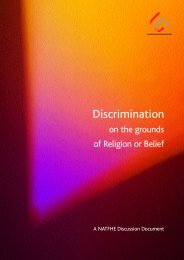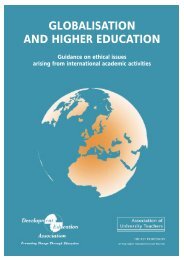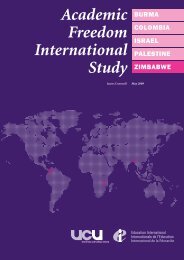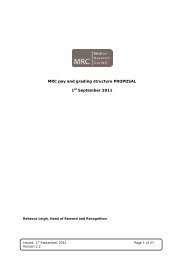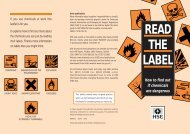The student-to-staff ratio in UK higher education - UCU
The student-to-staff ratio in UK higher education - UCU
The student-to-staff ratio in UK higher education - UCU
Create successful ePaper yourself
Turn your PDF publications into a flip-book with our unique Google optimized e-Paper software.
ASSOCIATION OF UNIVERSITY TEACHERSPack<strong>in</strong>g them <strong>in</strong> -<strong>The</strong> <strong>student</strong>-<strong>to</strong>-<strong>staff</strong> <strong>ratio</strong> <strong>in</strong> <strong>UK</strong><strong>higher</strong> <strong>education</strong>AUT RESEARCH, Oc<strong>to</strong>ber 2005
Table 2 – OECD <strong>ratio</strong> of <strong>student</strong>s <strong>to</strong> teach<strong>in</strong>g <strong>staff</strong> <strong>in</strong> tertiary <strong>education</strong>al<strong>in</strong>stitutions*1999 2000 2001 2002 2003France 16.9 : 1 18.3 : 1 18.1 : 1 17.9 : 1 17.6 : 1Germany 12.3 : 1 12.1 : 1 12.3 : 1 12.6 : 1 12.5 : 1Japan 11.5 : 1 11.4 : 1 11.3 : 1 11.2 : 1 11.0 : 1<strong>UK</strong> 18.5 : 1 17.6 : 1 17.6 : 1 18.3 : 1 18.2 : 1USA 14.0 : 1 13.5 : 1 13.7 : 1 17.1 : 1 15.2 : 1OECD country mean 15.3 : 1 14.7 : 1 16.5 : 1 15.4 : 1 14.9 : 1Based on full-time equivalents* <strong>in</strong>cludes Type A 3+ year ma<strong>in</strong>ly theoretical degrees & advanced research programmes, and Type B shorter more practicalcoursesSource: OECD Education at a Glance, series, Table D2.2Chart 2 – OECD <strong>ratio</strong> of <strong>student</strong>s <strong>to</strong> teach<strong>in</strong>g <strong>staff</strong> <strong>in</strong> tertiary <strong>education</strong>al<strong>in</strong>stitutions*Based on full-time equivalents* <strong>in</strong>cludes Type A 3+ year ma<strong>in</strong>ly theoretical degrees & advanced research programmes, and Type B shorter more practicalcoursesSource: OECD Education at a Glance, series, Table D2.2AUT research Oc<strong>to</strong>ber 2005AUT 2005 – SSR <strong>in</strong> <strong>UK</strong> HE 4
Endnotes1 http://www.hefce.ac.uk/pubs/hefce/2005/05_06/ para 442 In FTE calculation, part-time = 50% of full-time, except for 2003-4, when HESA New IndividualisedStaff Record FTE figure used; academic <strong>staff</strong> <strong>in</strong>cludes teach<strong>in</strong>g-only and teach<strong>in</strong>g-and-research <strong>staff</strong>,but excludes research-only <strong>staff</strong>. HESA’s New Individualised Staff Record from 2003-4 results <strong>in</strong> abreak <strong>in</strong> cont<strong>in</strong>uity <strong>in</strong> the data: the NISR <strong>in</strong> 2003-4 is designed <strong>to</strong> <strong>in</strong>clude academic <strong>staff</strong> work<strong>in</strong>g onless that a 25% FTE contract, and shows a large <strong>in</strong>crease <strong>in</strong> part-time teach<strong>in</strong>g-only <strong>staff</strong>, and a slightdecrease <strong>in</strong> teach<strong>in</strong>g-and-research academic <strong>staff</strong>. <strong>The</strong> 2003-4 NISR provides a <strong>staff</strong> FTE figure us<strong>in</strong>gproportion of contract data, and is therefore more accurate than the <strong>staff</strong> FTE for previous years.3 In FTE calculation, part-time = 50% of full-time, except for 2003-4, when HESA New IndividualisedStaff Record FTE figure used; academic <strong>staff</strong> <strong>in</strong>cludes teach<strong>in</strong>g-only and teach<strong>in</strong>g-and-research <strong>staff</strong>,but excludes research-only <strong>staff</strong>. HESA’s New Individualised Staff Record from 2003-4 results <strong>in</strong> abreak <strong>in</strong> cont<strong>in</strong>uity <strong>in</strong> the data: the NISR <strong>in</strong> 2003-4 is designed <strong>to</strong> <strong>in</strong>clude academic <strong>staff</strong> work<strong>in</strong>g onless that a 25% FTE contract, and shows a large <strong>in</strong>crease <strong>in</strong> part-time teach<strong>in</strong>g-only <strong>staff</strong>, and a slightdecrease <strong>in</strong> teach<strong>in</strong>g-and-research academic <strong>staff</strong>. <strong>The</strong> 2003-4 NISR provides a <strong>staff</strong> FTE figure us<strong>in</strong>gproportion of contract data, and is therefore more accurate than the <strong>staff</strong> FTE for previous years.4 Organisation for Economic Co-ope<strong>ratio</strong>n and Development5 <strong>The</strong> difference between the SSRs for the <strong>UK</strong> <strong>in</strong> tables 1 and 2 may be due <strong>to</strong> the use of differentfac<strong>to</strong>rs <strong>in</strong> calculat<strong>in</strong>g the full-time equivalent <strong>ratio</strong>: the fac<strong>to</strong>r used <strong>in</strong> table 1 was 0.5; the fac<strong>to</strong>r used <strong>in</strong>the OECD full-time equivalent data was not stated.See http://www.oecd.org/dataoecd/36/36/35324994.pdf6 OECD, Education at a Glance 2005, p. 348AUT 2005 – SSR <strong>in</strong> <strong>UK</strong> HE 5


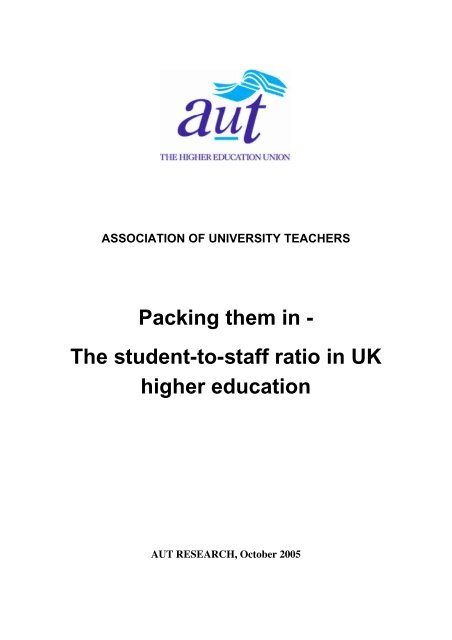
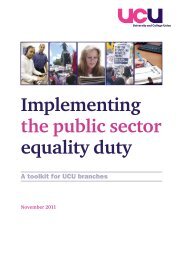
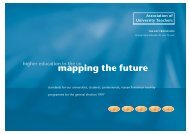
![(.pdf) [29kb] - UCU](https://img.yumpu.com/50914942/1/184x260/pdf-29kb-ucu.jpg?quality=85)

